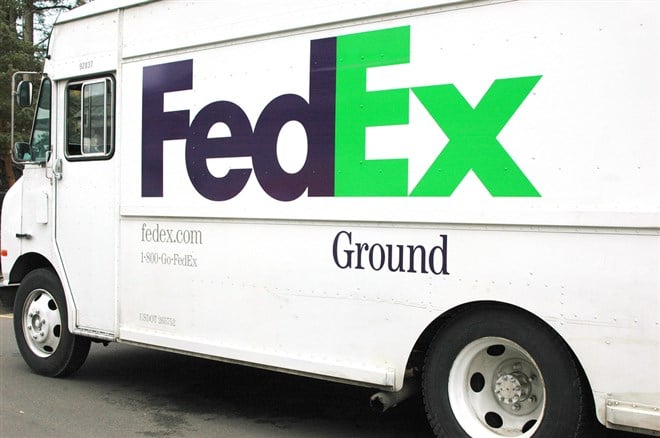
Last week FedEx (NYSE:FDX) reported an outstanding quarter. Record revenue and earnings beat expectations and management had bullish commentary around the current quarter. The result? FedEx stock sold off more than 5%.
The main culprit was that the company refrained from providing guidance. But given the highly unusual economic environment, this was actually a prudent decision.
The negative market sentiment also centered around the notion that growth may have peaked at FedEx. That theory seems unlikely given that the company is in the middle of its biggest holiday delivery season yet, not to mention it will soon be hauling COVID-19 vaccines around the world.
Let's take a closer look at why the dip in FedEx stock has created a great buy opportunity for one the of the pandemic economy's clear beneficiaries.
Why Did FedEx Stock Drop After Earnings?
The bar was undoubtedly set high for FedEx heading into its second-quarter report. The stock price and valuation ran up in anticipation of a big performance.
Sales rose 5.7% to a record $20.6 billion and EPS of $4.83 handily topped the consensus earnings estimate. But it wasn't enough to impress glass-half-empty traders who zeroed in on the limited visibility into FedEx's upcoming financials.
The market's trading pattern was a classic example of "buy the rumor, sell the news". This would be easier to accept if there were problems in a particular division or cracks in the fundamental story. But neither are the case. In fact, all FedEx operating segments are performing well. The shipping leader deserves a pass on the lack of guidance and lower margins.
Margins in the FedEx Ground business contracted amid higher compensation expense, COVID-19 safety protocols, and spending to boost its fleet. This has been a criticism of the bears. However, these cost increases aren't likely to be recurring at the same level and have been necessary to keep up with the elevated e-commerce volumes.
It's hard to criticize the company for doing what it has had to do to fulfill insane demand—and be one of the less appreciated essential workforces. Plus, lost in the mix was that FedEx's average cost per stop and fixed cost per package fell 15% and 9%, respectively last quarter. Over time, as economic conditions normalize, FedEx margins should improve.
What Should Investors Expect for FedEx's Current Quarter?
When FedEx reports fiscal third quarter results in mid-March, investors can expect to be treated to another strong performance. Although analyst estimates will change as the holiday quarter narrative evolves, the early Street forecast for Q3 EPS of $2.94 is more than double FedEx's Q3 earnings in fiscal 2020.
Whether the market reacts by giving credit where credit is due is anyone's guess. But depending on where overall market sentiment is at that point, we could very well see a day of reckoning in the FedEx share price. That is, if it hasn't already run up before then.
Media headlines about surging residential delivery demand during the holiday shopping season have the potential to re-energize FedEx stock. This could very quickly give the market amnesia about last quarter's decreased margins lack of guidance.
Meanwhile, its hard to ignore that FedEx is operating from a position of strength. It has a healthy balance sheet and a solid liquidity position that gives it the ability to not only meet near-term obligations but to deploy capital where needed to take advantage of growth opportunities.
Looking past the current boon in e-commerce, FedEx still has the acquisition of TNT Express in its back pocket as a future growth catalyst. As TNT Express continues to become integrated into its platform, FedEx will become an even stronger force in the global shipping and logistics market.
Is it a Good Time to Buy FedEx Stock?
FedEx shares are now trading at a reasonable if not cheap 17x forward earnings. Going forward it will face difficult comparisons to the above-normal growth it has experienced since the onset of the pandemic, but there's not much that can be done there. More importantly, the fundamental backdrop is very good. FedEx has pricing power like never before—and this together with record volumes is a dream scenario for a shipping company.
On the daily chart, FedEx has dipped below the lower Bollinger band line. This indicates that the move is atypical for the stock given its volatility history. It can also be viewed as a buy signal. Putting the March 2020 slide aside, similar breaches of the lower Bollinger band have sparked significant FedEx rallies. Fast forward a month or two from now and we could a similar rebound.
Despite the impacts of COVID-19 on the business, FedEx is in a great position to capitalize on this environment. So, when the FedEx delivery van rolls down your street for the fourth time today, take it as a reminder to scoop up some FedEx stock before it reports a blowout holiday quarter.
Before you consider FedEx, you'll want to hear this.
MarketBeat keeps track of Wall Street's top-rated and best performing research analysts and the stocks they recommend to their clients on a daily basis. MarketBeat has identified the five stocks that top analysts are quietly whispering to their clients to buy now before the broader market catches on... and FedEx wasn't on the list.
While FedEx currently has a Moderate Buy rating among analysts, top-rated analysts believe these five stocks are better buys.
View The Five Stocks Here
Enter your email address and we'll send you MarketBeat's list of ten stocks that are set to soar in Summer 2025, despite the threat of tariffs and other economic uncertainty. These ten stocks are incredibly resilient and are likely to thrive in any economic environment.
Get This Free Report
Like this article? Share it with a colleague.
Link copied to clipboard.